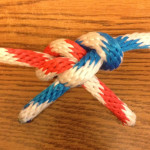
When you have to tie the ends of two large ropes (1/2 inch in diameter or larger) together, there is no better knot to use than the carrick bend. While many other knots reduce the strength of the rope considerably, a carrick bend reduces its strength only slightly. You’ll find that once a carrick bend is put under a big strain, it’s not all that hard to untie. The knot will tighten under the strain of the ropes, but won’t slip and works well with wet or slippery ropes.
The carrick bend looks very symmetrical when it’s first tied. But, as soon as it’s pulled tight, it looks quite different and is often hard to identify.
Start by making an underhand loop at the end of one rope and lay the end of the other rope under the loop (left hand photo). Then weave the end of the other rope over and under as you go (as shown in the middle and right hand photos).
PIONEERING — USE
- Joining the ends of two large diameter lines.
